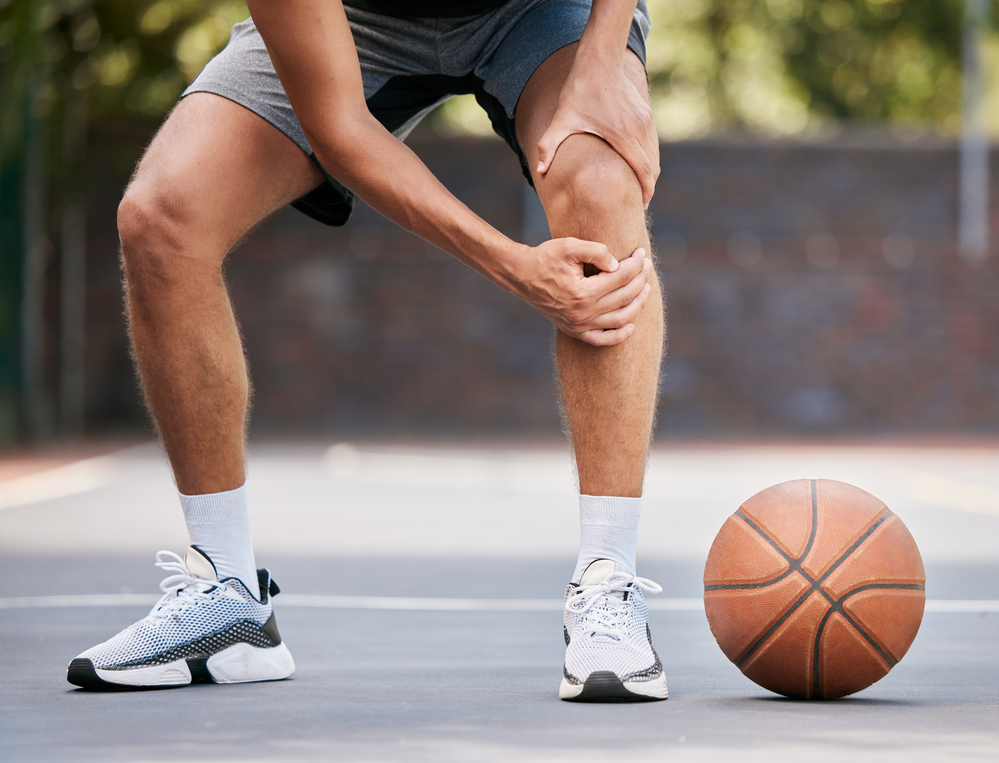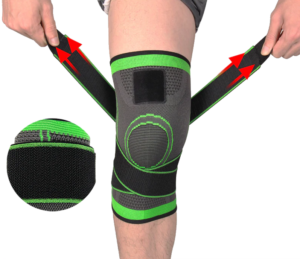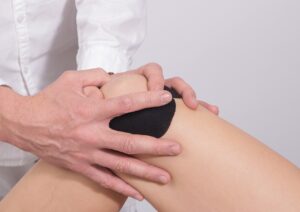
Basketball is an exhilarating sport that brings joy to millions of players around the world. However, as with any physical activity, it can also come with its fair share of challenges, one of them being knee pain. Whether you’re a professional athlete or just enjoy shooting hoops with friends, managing knee pain in basketball is crucial for maintaining your performance and preventing further injury. In this article, we will explore the causes of basketball knee pain and provide you with practical tips on how to deal with it effectively, so you can keep playing the game you love.

Prevention
No one wants to deal with knee pain, especially when it comes to playing basketball. Luckily, there are several preventative measures you can take to reduce the risk of knee injuries.
Proper warm-up and stretching exercises
Before hitting the court, it’s important to warm up properly and stretch your muscles and joints. This helps to increase blood flow and flexibility, preparing your body for the physical demands of basketball. Incorporate dynamic stretches such as leg swings, lunges, and high knee marches to effectively warm up your lower body.
Wearing supportive footwear
Choosing the right basketball shoes is essential for preventing knee pain. Look for shoes that provide adequate support and cushioning, as these can help absorb shock and reduce stress on your joints. Additionally, make sure your shoes fit properly and are appropriate for your playing style and surface type.
Maintaining a healthy weight
Carrying excess weight puts additional strain on your knees, increasing the likelihood of knee pain and injuries. By maintaining a healthy weight through a balanced diet and regular exercise, you can alleviate unnecessary stress on your joints and reduce the risk of developing knee issues.
Avoiding overuse and excessive training
While dedicated practice is important for improving your basketball skills, overdoing it can lead to knee pain. It’s crucial to give your body time to rest and recover, as overuse can cause inflammation and damage to your knees. Incorporate rest days into your training schedule and listen to your body’s signals to avoid pushing yourself too hard.
Strength and Conditioning
Building strength and conditioning is crucial for preventing knee pain and injuries in basketball. Here are some exercises to incorporate into your training routine:
Building quadriceps and hamstring strength
The quadriceps and hamstrings play a vital role in knee stability. Strengthening these muscle groups can provide support and protection to your knees. Exercises like squats, lunges, leg presses, and hamstring curls can be highly beneficial in developing the strength of these muscles.
Incorporating balance and stability exercises
Improving your balance and stability can help minimize the risk of knee injuries by enhancing your ability to maintain proper body alignment during basketball movements. Exercises like single-leg balance, heel-to-toe walks, and Bosu ball exercises can help improve your balance and stability.
Core strengthening exercises
A strong core is essential for maintaining proper body alignment and stability during basketball movements. Incorporate exercises like planks, Russian twists, and bicycle crunches to strengthen your core muscles.
Using resistance bands and weights
Incorporating resistance bands and weights into your training routine can help improve your overall strength and stability. Exercises such as lateral band walks, squats with resistance bands, and step-ups with weights can target the muscles surrounding your knees and lower body, reducing the risk of knee pain and injuries.
Proper Technique
Using proper technique during basketball movements is crucial for preventing knee pain. Here are some key aspects to focus on:
Using proper landing and jumping techniques
When jumping and landing, it’s important to maintain proper form and avoid excessive stress on your knees. Bend your knees and hips, land softly with your weight evenly distributed, and avoid excessive twisting or pivoting motions. Proper jumping and landing techniques can help prevent knee injuries such as ligament tears and cartilage damage.
Avoiding sudden directional changes
Quick changes in direction, especially when combined with pivoting motions, can put significant strain on your knees. Try to make controlled, gradual movements and avoid abrupt changes in direction to minimize the risk of knee pain and injuries.
Maintaining good posture and body alignment
Proper posture and body alignment during basketball movements help distribute forces evenly and reduce stress on your knees. Keep your chest up, shoulders back, and engage your core to maintain a neutral spine position. This alignment helps to minimize unnecessary strain on your knees.
Executing proper cutting and pivoting movements
Performing cutting and pivoting movements with proper technique can reduce the risk of knee pain and injuries. When cutting, ensure you maintain proper alignment and push off with the foot closest to the direction you want to go. When pivoting, be mindful of the amount of force exerted on your knees and make controlled movements to avoid excessive stress.
Rest and Recovery
Rest and recovery play a crucial role in preventing knee pain and injuries. Here are some strategies to incorporate:
Taking regular rest days
Allowing your body time to rest and recover is essential for preventing overuse injuries, including knee pain. Incorporate rest days into your training schedule to give your muscles and joints a chance to repair and rebuild.
Implementing active recovery exercises
Engaging in light exercises and stretches on your rest days can help promote blood flow, reduce muscle soreness, and improve joint mobility. Gentle activities like swimming, cycling, and yoga can be effective in aiding recovery and preventing knee pain.
Using ice and heat therapy
Applying ice to your knees after intense basketball sessions can help reduce inflammation and alleviate pain. Heat therapy, such as warm compresses or hot showers, can also help relax muscles and improve blood circulation, promoting recovery and preventing knee discomfort.
Getting sufficient sleep and rest
Adequate sleep is crucial for overall recovery and injury prevention. Aim for 7-9 hours of quality sleep each night to allow your body time to repair and rebuild tissues. Additionally, incorporate relaxation techniques into your routine, such as meditation or deep breathing exercises, to promote overall rest and recovery.
Physical Therapy
If you’re experiencing knee pain or have a history of knee injuries, seeking professional guidance through physical therapy can be beneficial. Physical therapists can provide targeted treatments and exercises to address your specific knee concerns. Here are some techniques commonly used in physical therapy:
Seeking professional guidance for rehabilitation
Working with a physical therapist allows you to receive personalized guidance and a structured rehabilitation program tailored to your knee pain and injuries. They can diagnose and assess the underlying causes of your knee pain and develop a treatment plan to aid in your recovery.
Performing targeted stretches and exercises
Physical therapists can guide you through specific stretches and exercises to address imbalances, enhance flexibility, and strengthen the muscles surrounding your knees. These exercises may include quad stretches, hamstring stretches, and various strengthening exercises that target your specific needs.
Using modalities such as ultrasound and electrical stimulation
Physical therapists may use modalities like ultrasound or electrical stimulation as part of your treatment plan. These non-invasive techniques can help reduce pain, promote tissue healing, and improve range of motion in your knees.
Considering manual therapy techniques
Manual therapy techniques, such as soft tissue mobilization or joint mobilization, can be used by physical therapists to improve joint mobility, reduce pain, and optimize movement patterns. These hands-on techniques can address tightness, scar tissue, and muscle imbalances that may contribute to knee pain.
Orthopedic Interventions
In some cases, orthopedic interventions may be necessary to manage knee pain that persists despite conservative treatments. Here are some options that a specialist might consider:
Exploring options like corticosteroid injections
Corticosteroid injections can be used to relieve pain and reduce inflammation in the knee joint. They are typically administered directly into the affected area and can provide temporary relief for conditions such as arthritis or tendonitis. However, it’s important to note that these injections may have limitations and should be used judiciously under the guidance of a medical professional.
Considering platelet-rich plasma (PRP) therapy
Platelet-rich plasma (PRP) therapy is a regenerative treatment that involves injecting a concentrate of the patient’s own blood platelets into the affected knee joint. PRP has shown promise in promoting tissue healing and reducing pain in certain knee conditions, although more research is needed to fully understand its effectiveness.
Assessing the need for arthroscopic surgery
In cases where conservative treatments have not alleviated knee pain, arthroscopic surgery may be considered. This minimally invasive surgical procedure allows the surgeon to diagnose and treat various knee conditions, such as meniscus tears or ligament injuries, using small incisions and a camera called an arthroscope.
Discussing surgical options with a specialist
For severe knee injuries or conditions that have not responded to conservative treatments, a specialist may recommend more extensive surgical interventions. Procedures such as knee replacement or ligament reconstruction may be considered to alleviate chronic knee pain and restore function. It’s important to consult with a specialist to discuss the potential risks, benefits, and alternatives before making any decisions.
Nutrition and Hydration
Proper nutrition and hydration play a vital role in preventing and managing knee pain. Here are some tips to consider:
Eating a balanced diet rich in anti-inflammatory foods
Incorporating foods with anti-inflammatory properties into your diet can help reduce inflammation in the body, including the knees. Include foods like fruits, vegetables, whole grains, fatty fish, nuts, and seeds, which contain antioxidants and omega-3 fatty acids that help combat inflammation.
Ensuring proper hydration before, during, and after games
Adequate hydration is crucial for maintaining joint flexibility and reducing the risk of knee pain and injuries. Drink water before, during, and after basketball games or training sessions to keep your joints well-lubricated and prevent dehydration, which can contribute to muscle imbalances and increased stress on your knees.
Considering nutritional supplements
In consultation with a healthcare professional, you may consider incorporating certain nutritional supplements to support joint health. Glucosamine and chondroitin sulfate are commonly used supplements that may help alleviate knee pain and support cartilage health. However, it’s important to discuss potential risks and benefits with a healthcare professional before starting any supplement regimen.
Avoiding excessive alcohol and caffeine consumption
Excessive alcohol and caffeine consumption can contribute to dehydration and inflammation in the body, which can worsen knee pain. Limit your intake of alcoholic and caffeinated beverages and opt for water or hydrating alternatives instead.
Injury Prevention Strategies
Implementing injury prevention strategies can significantly reduce the risk of knee pain and injuries on the basketball court. Here are some strategies to consider:
Implementing proper preventive taping and bracing techniques
Taping or bracing your knees can provide additional support and stability, reducing the risk of excessive movement and injury. Consult with a sports medicine professional to learn proper taping or bracing techniques specific to your knees and playing style.
Using knee pads or protective gear
Wearing knee pads or protective gear can help absorb shock and protect your knees from blows or collisions during gameplay. These protective measures can help reduce the risk of acute injuries while playing basketball.
Avoiding playing on hard surfaces
Playing on hard surfaces, such as concrete or asphalt, can increase the impact on your knees and contribute to knee pain. Whenever possible, choose to play on surfaces that have more give, like rubberized or wooden courts, to minimize the stress on your joints.
Monitoring and addressing muscle imbalances
Muscle imbalances can lead to altered biomechanics and increased stress on your knees. Regularly assess your strength and flexibility, and address any imbalances through targeted exercises and stretches recommended by a fitness professional or physical therapist.
Rehabilitation Techniques
If you do experience knee pain or have sustained a knee injury, rehabilitation is key to recovery and prevention of future issues. Here are some important considerations:
Following a structured rehabilitation program
Work with a physical therapist or sports medicine professional to develop a structured rehabilitation program that targets your specific knee concerns. This program will include exercises and techniques aimed at improving strength, flexibility, and mobility in your knees.
Gradually increasing activity levels
When recovering from knee pain or injury, it’s important to gradually increase your activity levels. Avoid returning to full intensity too quickly, as this can worsen your condition. Start with low-impact activities and slowly progress, paying attention to any signs of discomfort or pain.
Incorporating stretching and strengthening exercises
Stretching and strengthening exercises are fundamental for knee rehabilitation. Your rehabilitation program should include exercises that target the muscles surrounding your knees, improving flexibility and strength to support the joint.
Using modalities like ultrasound and heat therapy
Modalities such as ultrasound and heat therapy may be incorporated into your rehabilitation program to promote healing, reduce pain, and improve joint mobility. These treatments can be performed by a physical therapist or under their guidance.
Seeking Professional Guidance
When it comes to managing knee pain in basketball, it’s essential to seek professional guidance to ensure proper diagnosis and treatment. Here are some important steps to take:
Consulting a sports medicine specialist or orthopedic surgeon
If you’re experiencing persistent knee pain or have sustained a severe knee injury, make an appointment with a sports medicine specialist or orthopedic surgeon. These professionals have specialized knowledge and experience in diagnosing and treating knee conditions commonly seen in athletes.
Getting a thorough evaluation and diagnosis
During your appointment, the specialist or surgeon will perform a thorough evaluation of your knee, which may include physical examinations, imaging studies, and a discussion of your symptoms and medical history. This evaluation will help determine the underlying cause or causes of your knee pain.
Receiving personalized treatment plans
Based on the evaluation and diagnosis, the specialist or surgeon will develop a personalized treatment plan tailored to your knee pain and individual needs. This plan may include a combination of conservative treatments, physical therapy, and, in some cases, surgical interventions.
Accessing specialized resources and equipment
Sports medicine specialists and orthopedic surgeons have access to specialized resources, such as advanced imaging technology and state-of-the-art equipment, that can aid in the diagnosis and treatment of knee pain. By seeking professional guidance, you can benefit from these resources and receive the most appropriate care for your knee condition.
In conclusion, preventing and managing knee pain in basketball requires a multi-faceted approach that encompasses proper warm-up and stretching exercises, strength and conditioning training, proper technique, rest and recovery, physical therapy, orthopedic interventions, nutrition and hydration, injury prevention strategies, rehabilitation techniques, and seeking professional guidance when necessary. By implementing these strategies and following a comprehensive plan, you can reduce the risk of knee pain, improve performance, and enjoy the game of basketball with a healthy and pain-free set of knees.





